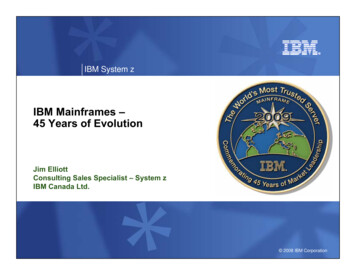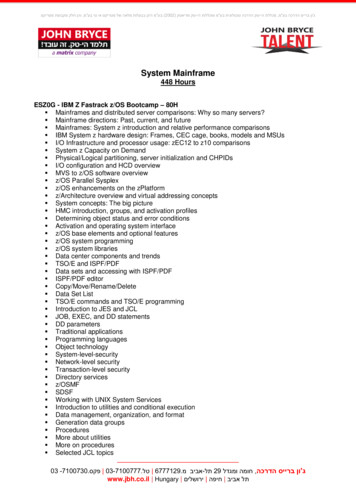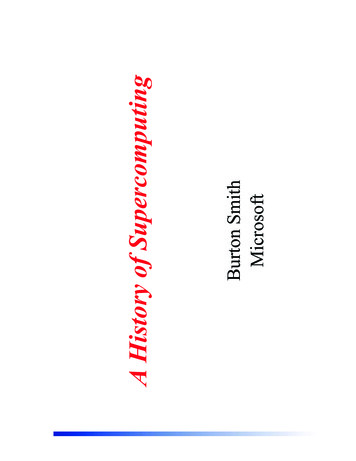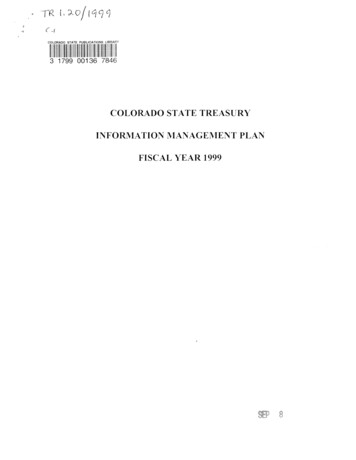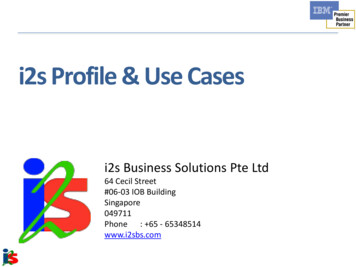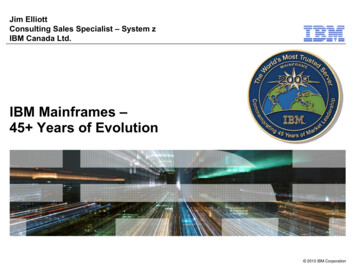
Transcription
Jim ElliottConsulting Sales Specialist – System zIBM Canada Ltd.IBM Mainframes –45 Years of Evolution 2010 IBM Corporation
IBMReports of the death of themainframe were premature “I predict that the last mainframe willbe unplugged on March 15, 1996.”– Stewart Alsop, March 1991 “It’s clear that corporate customersstill like to have centrally controlled,very predictable, reliable computingsystems – exactly the kind ofsystems that IBM specializes in.”– Stewart Alsop, February 2002Source: IBM Annual Report 20012 2010 IBM Corporation
In the BeginningThe First Two Generations 2010 IBM Corporation
IBMWell, maybe a little before IBM started out as a merger ofthree US companies, whichbecame units of CTR– Computing Scale– Tabulating Machine– Time Recording The Canadian unit became theInternational Business MachinesCo. Ltd. in 1917 The parent became InternationalBusiness Machines Corporation in19244 2010 IBM Corporation
IBMThe family tree – 1952 to 1964 Several mainframe familiesannounced, designed fordifferent applications Every family had a different,incompatible architecture Within families, moving from onegeneration to the next was amigration– Common compilers mademigration easier – COBOL andFORTRAN5 2010 IBM Corporation
IBMIBM 701 – 19521st generation The first IBM large-scale electronic computer manufactured inquantity IBM's first commercially available scientific computer The first IBM machine in which programs were stored in an internal,addressable, electronic memory The first of the pioneering lineof IBM 700 series computers,including the 702 through 7097016 2010 IBM Corporation
IBMIBM 305 RAMAC – 19561st generation The first computer to include a diskdrive (named the IBM 350 Disk File) Prior to this magnetic computerstorage had consisted of corememory, tape, and drums The 350 Disk File consisted of astack of fifty 24 inch discs The capacity of the entire disk filewas 5 million 7-bit characters, whichworks out to about 4.4 MB in modernparlance7 350 Disk 2010 IBM Corporation
IBMIBM 1401 – 19592nd generation The all-transistorized IBM 1401 Data Processing System placed thefeatures found in electronic data processing systems at the disposal729140214011403of smaller businesses,previously limited to the use ofconventional punched cardequipment These features included: highspeed card punching andreading, magnetic tape inputand output, high speedprinting, stored program, andarithmetic and logical ability8 2010 IBM Corporation
IBMIBM 1440 – 19622nd generation Low-cost system specifically designed to solve the increasing datahandling problems of smaller volume businesses The 1440 met the need for a144314411311complete accounting systemand offered the benefits of abusiness information system With a variety of models andspecial features available forthe 1440, a system could betailored to meet immediatedata processing requirementsand expanded to absorbincreased demands9 2010 IBM Corporation
IBMIBM 7094 – 19622nd generation Built for large-scale scientific computing Compatible with the IBM 7090, the advanced solid-state IBM 7094offered substantial increases in internal operating speeds andfunctional capacities7094 New expanded functions providedwith the IBM 7094 weredouble-precision floating-pointoperations and seven index registers10 2010 IBM Corporation
The April 1964 Revolution3rd generation 2010 IBM Corporation
IBMDuring the 1950s, Data Processing came of age Data Processing machines existed – sorters, collators, tabulators “Computers” were devoted almost entirely to the processing ofcomputationally intensive tasks Demand for computers, as data processing machines, boomed andnew machines were built to meet this demand Customers were getting very frustrated with migration costs thatcame with processor upgrades12 2010 IBM Corporation
IBM13 2010 IBM Corporation
IBMSystem/360 – Announced April 7, 1964 IBM decided to implement a wholly new architecture specificallydesigned both for data processing and to be compatible across awide range of performance levels IBM invested 5B to develop a family of five increasingly powerfulcomputers that run the same operating systems and can usethe same 44 peripheral devicesS/360-75with the same architecture– Architecture published in the S/360Principles of Operation– 24-bit addressing (32-bit architecture)– Solid logic circuit cards2401142311 2010 IBM Corporation
IBMSystem/360 – a child is born Hardware– One main storage, maximum size is 16MB– One or two Central Processing Units (CPUs)– One to seven Channels- Selector or Byte Multiplexor- Block Multiplexor– Control Units (which connect to Channels)– Devices (which connect to Control Units) Family of operating systems from IBM– Operating System/360 (OS/360)– Disk Operating System/360 (DOS/360)– Tape Operating System (TOS)– Basic Programming Support (BPS)– Airlines Control Program (ACP)15 2010 IBM Corporation
IBMCoreMemory16 2010 IBM Corporation
IBMS/360 familyModelAnnouncedFirst ShippedWithdrawnModelAnnouncedFirst ShippedWithdrawn20 518-Nov-64Apr-66n/a6522-Apr-65Nov-65 6 6,715-Mar-77253-Jan-68Oct-687-Oct-77707-Apr-64Not Shipped ot Shipped 3n/a607-Apr-64Not Shipped 122-Apr-6595Feb-68n/a627-Apr-64Not Shipped 122-Apr-65195Mar-719-Feb-771.2.3.4.5.6.7.n/a 17420-Aug-69Replaced by Model 65.Replaced by Model 75.Redesignated as Model 91.Offered on special government contract.Model 20 architecture differed in some respects from other S/360 models.MP models of the Model 65 and Model 67 were made available in 1968.The S/360-67 was the first Virtual Storage mainframe from IBM.Not available.Sources: A. Pedegs, "System/360 And Beyond," IBM Journal Of Research And Development, Vol. 25, No. 5, September 1981, Table 2, p. 387;various data on file in IBM Corporate Archives. 2010 IBM Corporation
IBMSystem/360 Model 2019662560 Multi-Function Card Machine Special purpose“entry level” S/360 24K of core memory Half the registers ofother models Instruction set thatwas not binarycompatible with therest of the S/360family Popular as an RJEworkstation18 2010 IBM Corporation
IBMSystem/360 Model 67 First IBM system with virtual storage capabilities– S/360 Model 65 with addition of the Dynamic Address TranslationfacilityS/360-67 Operating systems– Time Sharing System (TSS) –The “official” operating systemfrom IBM Data Systems Division– Control Program/67 (CP/67) with theCambridge Monitor System CMS) –The “unofficial” operating systemfrom the IBM Cambridge ScientificCenter“DAT box”– Michigan Terminal System (MTS)from the University of MichiganUniversity of Newcastle Upon Tyne19 2010 IBM Corporation
IBMIBM 9020 SystemAir Traffic Control system The 9020 was a conglomeration of IBM System 360 computers– Models were made up of IBM System 360 Model 65s hooked togetherinto a highly redundant and reliable single system image and Model 50’sas IO Control Elements Here is a picture of the operator control panel forone computing element of a 9020E system, whichlooked a great deal like a Model 65 panel, but withadditions specific to the air traffic controlconfiguration A complete 9020E was made up of three or fourModel 65s, three Model 50s, storage units, andperipheral adapters for things like displays andincoming radar data20 2010 IBM Corporation
IBMSystem/370 – Announced June 30, 1970 Compatible upgrade from S/360 370 Model 145 is the first computer with fully integrated monolithicmemory (circuits in which all of the same elements – resistors,capacitors and diodes – are fabricated on a single slice of silicon)and 128-bit bi-polar chips New peripherals“We are confident that the performance– 3330/3340/3350 diskof System/370, its compatibility, its– 3211 printerengineering and its programming willmake it stand out as the landmark forthe 1970s that System/360 was for theSixties.”Tom Watson, Jr.IBM Chairman and CEO1961-197121 2010 IBM Corporation
IBMSystem/370 with Virtual StorageAnnounced August 2, 1972 Compatible upgrade from S/370 with virtual storage First popular multiprocessor models (158MP, 168MP) Family of operating systems3850 Mass Storage Subsystem– OS/360 OS/VS3705S/370-148– DOS/360 DOS/VS– CP/67 VM/3703505223203352533503270 2010 IBM Corporation
IBMS/370 – the architecture matures Virtual storage– 2KB or 4KB pages of memory– 64KB or 1MB segment sizes– Translation of virtual addresses toreal addresses using DynamicAddress Translation (DAT) logic– Segment tables point to pagelocations Channel architecture– 256 channels CPU changes– Extended MP support via CPUaddress2330333031 2010 IBM Corporation
IBMS/370 familyModelAnnouncedFirst ShippedWithdrawnModelAnnouncedFirst 0-Jun-70Jan-71 -76Sep-76 r-71 eb-76Jun-76 n-76Jan-771-Nov-831. Shortly after the August 2nd, 1972 announcement, DAT box (address relocation hardware) upgrades for the S/370-155 and S/370-165 werequietly announced, but were available only for purchase by customers who already owned a Model 155 or 165. After installation, these modelswere known as the S/370-155-II and S/370-165-II. The original S/370-155 and S/370-165 were the only S/370 machines which were not VirtualStorage capable.2. An Attached Processor (AP) model of the S/370-158 and Multi-Processor models of the S/370-158 and S/370-168 were made available in 1976with the “-3” update. Sources: A. Pedegs, "System/360 And Beyond," IBM Journal Of Research And Development, Vol. 25, No. 5, September 1981, Table 2, p. 387;various data on file in IBM Corporate Archives.24 2010 IBM Corporation
IBMS/370 family continues3032ModelAnnouncedFirst ShippedWithdrawn30316-Oct-77Mar-78 r-78 v-801981 1Q5-Feb-85308112-Nov-801981 4Q4-Aug-874331 4381-E 5Feb-88n/aAug-881.2.3.4.5.n/a 25An MP model of the 3033 was made available in 1978.An AP model of the 3031 was made available in 1979.An AP model of the 3033 was made available in 1980.The 4321 was a half speed model of the 4331-2 made available only in the US.The 4381-E models were 4381-2 models modified to support ESA/370 via LICC.Not available.Sources: A. Pedegs, "System/360 And Beyond," IBM Journal Of Research And Development, Vol. 25, No. 5, September 1981, Table 2, p. 387;various data on file in IBM Corporate Archives. 2010 IBM Corporation
IBMSystem/370 with Extended Architecture Evolution of S/370 3081 introduced ThermalConduction Modules New peripherals– 3800 page printer– 3370/3380 disk– 3480 tape Family of operating systems– OS/VS MVS/SP MVS/XA– DOS/VS VSE/SP– VM/370 VM/SP, VM/SP HPO– VM/370 VM/XA MA VM/XA SF VM/XA SP263083 2010 IBM Corporation
IBM370-XA – radical surgery for the architecture Extended storage addressing– 24-bit or 31-bit addressing– 4KB pages in 1MB segments Interpretive execution facility– Start Interpretive Execution (SIE) instruction– SIE runs until interception condition raised– Used by VM/XA– Multiple High Performance Guest Support Facility (MHPGSF) to support V Fguests on VM/XA SP Rename Processor Resource/Systems Manager (PR/SM) when Logical Partitions(LPAR) announced 370-XA channel design– CHPIDs– Subchannels27 2010 IBM Corporation
IBMSystem/370 with Enterprise Systems Architecture Extension of 370-XA– Expanded Storage– Multiple 31-bit address spaces Common set of peripheral devices– 3390 disk– 3490 tape Family of operating systems– MVS/XA MVS/ESA– VSE/SP VSE/ESA– VM/XA SP VM/ESA283090 2010 IBM Corporation
IBMSystem/390 with Enterprise Systems ArchitectureAnnounced September 1990 Evolution of ESA/370 1994 – S/390 Parallel Transaction Server– Family of CMOS processors 1998 – System/390 Generation 5 server – more than 1,000 MIPS 1999 – System/390 Generation 6 server – copper chip technology Common set of peripheral devices– RAMAC, Enterprise Storage Subsystem disk– 3590 Magstar tape Family of operating systems– MVS/ESA OS/390– VSE/ESA– VM/ESA– AIX/ESA– Linux for S/390 (December 1999)299672-G5ES/9000 2010 IBM Corporation
IBMS/370 to ES/9000 evolution30115/125138/148158/168 4331 432143413031/3032/3033 436143813081/3083/3084 upgrade 93704381-E3090 upgrade upgrade922191219021 2010 IBM Corporation
IBMParallel Transaction Server to G61994-04-069672-Enn,9672-PnnParallel Transaction Server1994-09-139672-Rn1Parallel Enterprise 4G31996-09-102003Multiprise 9-207060Multiprise 30001999-05-039672-nn7G6Multiprise 300031 2010 IBM Corporation
IBMeServer zSeries with z/ArchitectureAnnounced October 2000 Evolution of ESA-390– 24-bit, 31-bit, and 64-bit addressingsupported concurrently– z900 – up to 16 processors– z800 – up to 4 processorszSeries 900 Linux-only model in January 2002 General purpose model in February 2002- Integrated Facility for Linux on z900/z890 Family of operating systems– OS/390 z/OS– VSE/ESA z/VSE– VM/ESA z/VM– TPF z/TPF– Linux for S/390 Linux for zSeries32 2010 IBM Corporation
IBMeServer zSeries Enhanced May 2003– z990 – up to 32 processors – configurable as CPs, IFLs, SAPs– Up to 256GB memoryzSeries 990 October 2003– The Mainframe Charter April 2004– z890 – up to 4 configurable processors– zSeries Application Assist Processor October 2004– Crypto Express 2 January 2005– FICON Express 233 2010 IBM Corporation
IBMSystem z9 ECAnnounced July 26, 2005 Strengthening the role of the mainframe as the data hub of theenterprise New versatile capacity settings designed to optimize capacity andcost IBM System z9 Integrated Information Processor (IBM zIIP) isdesigned to improve resource optimization and lowerthe cost of eligible work Continued improvement in IBM FICON performanceand throughput On demand innovative technologies to help meetever-changing business demands34 2010 IBM Corporation
IBMSystem z9 BCAnnounced April 27, 2006 IBM System z9 technology, for entry level to midsize capacity needs,with a wide choice of capacity settings and highly granular growthoptions, an increase of 2.6 times more capacity settings than zSeriesz890 A broad set of specialty engines to facilitate integration of manytypes of workloads and fully leverage the power of the mainframe Helps protect client’s investments in mainframetechnologies with upgradeability from z890 and z800 servers Key System z9 features of advanced security, resiliency,virtualization and connectivity technologies delivered in amidrange package35 2010 IBM Corporation
IBMSystem z10 ECAnnounced February 26, 2008 Unprecedented capacity and virtualization to meet consolidationneeds Improvements connecting to data and the network can help providefaster access to data Just-In-Time deployment of resources Specialty engines offer an attractive alternative when running newworkloads Enhanced accuracy to a time External Time Source36 2010 IBM Corporation
IBMSystem z10 BCAnnounced October 21, 2008 Industry leading combination of System z10 security, resiliency,virtualization and connectivity technologies packaged specifically asa midrange enterprise solution Specialty engines offer an attractive alternative when running newworkloads Save energy via consolidation of disparate workloads and reducecosts via virtualization capabilities for more efficient resourcesharing Enables future growth—as a modern platform for a growing portfolioof business solutions Up to 50% more performance at half the price for incremental Linuxworkloads compared to the System z9 BC37 2010 IBM Corporation
IBMIBM zEnterprise system – Best in class technologiesAnnounced 2010-07-22UnifiedUnified managementmanagement forfor aa smartersmarter system:system:zEnterprisezEnterprise UnifiedUnified ResourceResource ManagerManagerTheThe world’sworld’s fastestfastest andandmostmost scalablescalable system:system: zEnterprise196 (z196)(z196)zEnterprise 196 Ideal for large scaledata and transactionserving and missioncritical applications Most efficientplatform for Largescale Linux consolidation Leveraging a largeportfolio of z/OS andLinux on System zapplications Capable of massivescale up, over 50Billion Instructionsper Second (BIPS) Provides platform, hardware andworkload management Unifies management of resources,extending IBM System z qualities ofservice across the infrastructureScaleScale outout toto aa trilliontrillioninstructionsinstructions perper second:second:zEnterpriseBladeCenterzEnterprise BladeCenter ExtensionExtension (zBX)(zBX) Selected IBM POWER7 blades and IBM x86Blades1 for tens ofthousands of AIX andLinux applications High performanceoptimizers andappliances to acceleratetime to insight andreduce cost Dedicated highperformance privatenetworkHMC1 All statements regarding IBM future direction and intent are subject to change or withdrawal without notice, and represents goals and objectives only.38 2010 IBM Corporation
IBMIBM System z: System Design ComparisonSystem I/O Bandwidth288 GB/Sec*Balanced SystemCPU, nWay, Memory,I/O Bandwidth*172.8 GB/sec*96 GB/secMemory3 TB**24 GB/sec1.5 TB**512 GB256GB30064GB450600920PCI for1-way120216-way32-wayz196* Servers exploit a subset of its designed I/O capability** Up to 1 TB per LPARPCI - Processor Capacity Index3954-wayz10 EC64-wayz9 ECzSeries 99080-wayProcessorszSeries 900 2010 IBM Corporation
IBM9672-G5 to eServer zSeries to System z10 to 62000-10-032064-1nnz9002002-04-302064-2Cnz900 Turbo2009-01-292006-0FLz800 Linux only 72086z8902005-07-262094System z9 EC (originally System z9 109)2006-04-272096System z9 BC2008-02-262097System z10 EC2008-10-212098System z10 BC2010-07-222817zEnterprise 19640 2010 IBM Corporation
April 7, 2009 – The 45th Anniversary! 2010 IBM Corporation
IBMApril 7, 2004 – The 40th ries/misc/bookoffer/download/360revolution 040704.pdf42 2010 IBM Corporation
IBMSummary From System/360 in 1964 to today’s zEnterprise System, we haveseen an evolution that has preserved customer investments in aunique way From OS/360 to MVS to OS/390 to z/OS, we have seen an evolution ofthe operating system that is core to most corporate IT environments From DOS/360 to VSE/ESA to z/VSE, we have seen this operatingsystem thrive meeting the needs in smaller environments From CP/67 as a research project and VM/370 as a migration tool, VMhas evolved to today’s z/VM as the core of IBM’s System zvirtualization technology And now with Linux on System z, we have a truly open operatingenvironment“Legacy systems are systems that work!”44 2010 IBM Corporation
IBMBibliography Melinda Varian, Princeton– “VM and the VM Community: Past, Present, and Future” presented at SHARE 89, 1997 Jeff Gribbin, EDS UK– “Development of 360/370 Architecture – A Plain Man’s View”, 1989 Chuck Boyer– “The 360 Revolution”, 2004 available bookoffer/download/360revolution 040704.pdf IBM Archives: Valuable resources on IBM's history– http://www.ibm.com/ibm/history/ IBM Systems Journal– “VM/370–a study of multiplicity and usefulness”L H Seawright and R A MacKinnon, Volume 18, Number 1, 1979– Evolution of a virtual machine subsystemE C Hendricks and T C Hartmann, Volume 18, Number 1, 1979– “ESA/390 interpretive-execution architecture, foundation for VM/ESA”D L Osisek, K M Jackson, and P H Gum, Volume 30, Number 1, 1991 IBM Journal of Research and Development– “The Origin of the VM/370 Time-Sharing System”R J Creasy, Volume 25, Number 5, 1981– “System/360 and Beyond”A Padegs, Volume 25, Number 5, 198145 2010 IBM Corporation
IBMNotices Copyright IBM Corporation 2000, 2010. All rights reserved.This document contains words and/or phrases that are trademarks or registered trademarks of theInternational Business Machines Corporation in the United States and/or other countries. Forinformation on IBM trademarks go to http://www.ibm.com/legal/copytrade.shtml.The following are trademarks or registered trademarks of other companies.Java and all Java-related trademarks and logos are trademarks of Sun Microsystems, Inc., in the UnitedStates and other countries.UNIX is a registered trademark of The Open Group in the United States and other countries.Microsoft, Windows and Windows NT are registered trademarks of Microsoft Corporation.Red Hat, the Red Hat "Shadow Man" logo, and all Red Hat-based trademarks and logos are trademarksor registered trademarks of Red Hat, Inc., in the United States and other countries.Linux is a trademark of Linus Torvalds in the United States, other countries, or both.All other products may be trademarks or registered trademarks of their respective companies.Notes:This publication was produced in Canada. IBM may not offer the products, services or featuresdiscussed in this document in other countries, and the information may be subject to change withoutnotice. Consult your local IBM business contact for information on the product or services available inyour area.All statements regarding IBM's future direction and intent are subject to change or withdrawal withoutnotice, and represent goals and objectives only.Information about non-IBM products is obtained from the manufacturers of those products or theirpublished announcements. IBM has not tested those products and cannot confirm the performance,compatibility, or any other claims related to non-IBM products. Questions on the capabilities of non-IBMproducts should be addressed to the suppliers of those products.Prices subject to change without notice. Contact your IBM representative or Business Partner for themost current pricing in your geography.46 2010 IBM Corporation
IBM IBM 701 - 1952 1st generation 701 The first IBM large-scale electronic computer manufactured in quantity IBM's first commercially available scientific computer The first IBM machine in which programs were stored in an internal, addressable, electronic memory The first of the pioneering line of IBM 700 series computers,


